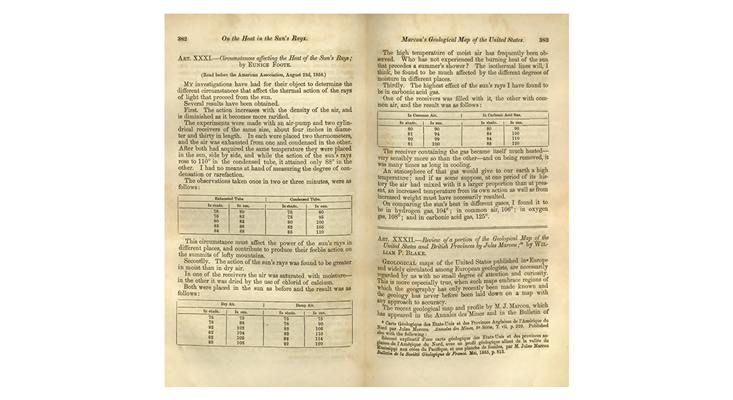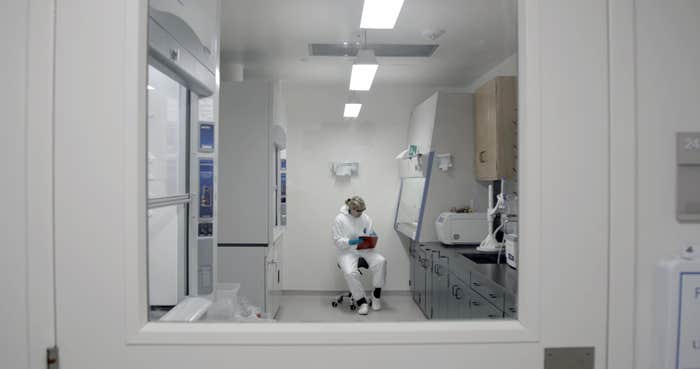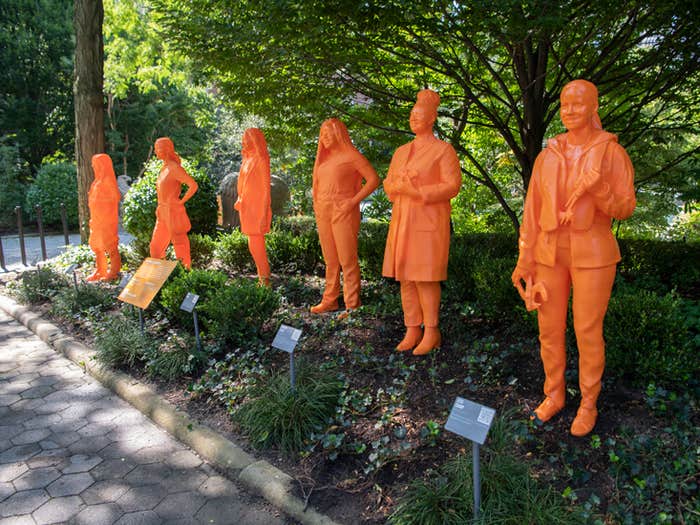Human-induced climate change may seem a purely modern phenomenon. Even in ancient Greece, however, people understood that human activities can change climate. Later the early United States was a lab for observing this as its settlers altered nature. By 1800 it was known that the mass clearing of forests raised temperatures in the Eastern U.S. and that climatic changes followed the pioneers as they spread west.
The causes for such changes, and the understanding that they could have global scope, came from eminent European scientists. Yet an amateur 19th-century American researcher, a woman named Eunice Foote, made a first crucial discovery about global climate change. Her story gives insight into early American science, women in science, and how the understanding of climate has changed. It also reveals how that understanding might have evolved differently to better deal with today’s climate problems.
“Foote went from a farmer’s daughter to one of the greats in the science of climate change,” says John Perlin, a visiting scholar at the University of California, Santa Barbara, and author of books on solar power and other topics. Perlin is currently writing a book about Foote. His extensive archival research and a visit to the locales where she lived and worked have yielded new understanding of her environment and development.
The story of climate change begins in the 1820s, when the French scientist Joseph Fourier discovered the greenhouse effect by recognizing that atmospheric gases must trap the sun’s heat. In 1859 the Irish physicist John Tyndall identified atmospheric water vapor and carbon dioxide gas, CO2, as main components in absorbing thermal radiation. But in a lost piece of scientific history recovered only in 2011, Foote scooped Tyndall by three years when her experiments in 1856 first revealed the roles of water vapor and CO2. Atmospheric CO2 levels at the time were only about 290 parts per million (ppm) and global climate change was not yet a known issue. Nevertheless, Foote predicted that changing CO2 levels could change global temperatures, as we see today with CO2 at over 400 ppm.
Who was Eunice Foote? At the time of her discovery she was a 37-year-old wife and mother. Born Eunice Newton in 1819 on a farm in Connecticut and raised largely by an older sister, she lived much of her life in upper New York state—a life marked by events that contributed to her scientific success.
“Foote went from a farmer’s daughter to one of the greats in the science of climate change.”
One factor was her excellent schooling. From age 17 to 19, Foote attended the Troy Female Seminary in Troy, New York. This “mecca for women” had been founded by feminist Emma Willard in 1824 as the first women’s prep school. It shared facilities with the nearby Rensselaer School (later Rensselaer Polytechnic Institute), whose co-founder Amos Eaton was a particular proponent of hands-on science training. Along with science-heavy curricula, according to Perlin, the schools featured the only two chemistry labs in the world then meant just for students. It was here, he says, that Foote learned lab technique and how to frame and carry out a research project.
Foote was also influenced by a famous neighbor, Elizabeth Cady Stanton, a major figure in early women’s rights and suffrage movements who later worked with Susan B. Anthony. Stanton co-organized the first woman’s rights convention held in the U.S., which met in Seneca Falls, NY, in 1848. Foote attended, and signed the convention’s “Declaration of Sentiments” that stated the societal changes necessary to fully include women. More than that, she helped prepare the conference proceedings. Perlin believes she was especially motivated by a resolution that all the professions should be open to women.
As Perlin points out, next to Foote’s signature on the Declaration of Sentiments you would have seen her husband Elisha’s signature. He was one of only a few male attendees who actually signed, a demonstration of his support that must have been meaningful to Eunice. Elisha also shared her scientific interests. He knew Joseph Henry, the leading American scientist of the time and the founding secretary of the Smithsonian Institution. Elisha carried out meteorological work for the Smithsonian and together with Eunice read Henry’s writings about climate.

All these influences contributed to Foote’s breakthrough paper, “Circumstances Affecting the Heat of the Sun’s Rays.” It was presented at the 1856 meeting of the American Association for the Advancement of Science (AAAS)—but not by her. Elisha read his own research paper whereas Eunice’s was introduced and read by Henry. Unlike the other reports at that meeting, it was not published in the proceedings. Nevertheless, it became somewhat known. It was briefly described in a few newspapers. Scientific American wrote that Eunice’s work offered “abundant evidence of the ability of woman to investigate any subject with originality and precision.” Fortunately, it did appear in full under Foote’s name in the 1856 issue of The American Journal of Science and Arts.
But then her discovery became lost. It might have remained so except for retired petroleum geologist Raymond Sorenson and a dose of what he calls “blind luck.” He collected old copies of the Annual of Scientific Discovery, a yearly summary of scientific research. In the volume for 1857, Sorenson came across a description of Foote’s work, and quickly realized that he was seeing the first reported connection between CO2 and climate change. In 2011 he presented his findings in a journal published by his professional society. “I’ve had more response to that than anything else I’ve ever written,” he has said, attention that continues as scientists and historians absorb the revelation of Foote’s work—especially in 2019, the 200th year after her birth.
“I have been wondering how many Eunice Footes are out there to be discovered.”
Foote’s research used simple apparatus, two cylinders (presumably made of clear glass) 4 inches across by 30 inches long that each held two thermometers. She filled these tubes with different gases and compared their thermal responses to sunlight as judged by their temperature rises. Foote found that moist air absorbs more solar radiation than dry air; and what she called carbonic acid gas, that is CO2, absorbs more radiation than ordinary air. That tube reached a temperature of 120 degrees Fahrenheit compared to 100 degrees Fahrenheit for ordinary air, and cooled more slowly. She also found that the tube with CO2 became much hotter than tubes filled with hydrogen or oxygen under equal conditions.
Foote unquestionably preceded Tyndall in discovering the major roles of CO2 and water vapor. This was remarkable for an amateur from the young American scientific community, compared to an educated professional working within a mature European scientific setting. Tyndall, however, established a critical feature that Foote had not. Using an infrared source in his well-equipped lab, he showed the greenhouse effect is not triggered by direct sunlight but by infrared radiation arising from the earth’s warmed surface. Foote’s experiment was not designed to distinguish between the two modes (although present-day analysis shows evidence of the infrared effect in her data). Tyndall deserves credit for uncovering this essential part of the greenhouse mechanism.
One lesson from Foote’s life is that original research arises from access to a scientific education and opportunities for mentorship and discussions. Multiple studies show the same holds true today. It’s also important to reflect on how Foote’s research was received. Why couldn’t she present her own work at AAAS, and why was it omitted from the published proceedings? Why didn’t her work receive wider attention? As Leila McNeill underscored in Smithsonian.com, bias against women is a large part of the answer. Women could join the AAAS in that era, but science historian Margaret Rossiter notes an internal hierarchy in the organization that rated “professional” men over “amateur” women. This may account for the downgrading of Foote’s presentation.
Later, Tyndall made a more serious omission. The papers he wrote about his discovery in 1859 and then in 1861—now five years after Foote’s work—did not mention her results, although he cited those of Fourier and others. Priority of discovery has always been a serious matter in science. With no citation to Foote’s work, Tyndall took center stage as “the father of climate science.” Equally important in the long run, his omission also kept Foote’s work from contributing to climate science as it developed in Europe.
Sexism colored Tyndall’s perception of women as scientists, as revealed in a passage from the biography, The Ascent of John Tyndall. The book’s author Roland Jackson writes that Tyndall “often exhibited surprise at women’s intellectual capabilities, and though he imagined that women could understand anything revealed by the savants, he did not believe they had the same powers of imagination and discovery.”
Was this attitude enough to make Tyndall purposely ignore Foote’s work? In an article published in 2019, Jackson denies the possibility. He argues that poor communication between American and European science makes it likely that Tyndall simply did not know of Foote’s research. He adds that covering up her work would not have been in Tyndall’s character. Perlin, however, believes the omission was deliberate. He argues that Foote’s research appeared in publications where Tyndall was virtually certain to have seen it. Perlin also notes a separate incident where Tyndall failed to credit earlier work by another American researcher (who happened to be Joseph Henry).
Whatever the link is between Tyndall and his treatment of Foote’s research, his attitude echoed what many of his male colleagues thought about women in science. Despite this barrier, Foote is an inspiration for female scientists today. One of them, Leila Carvalho, is a professor of meteorology and climate sciences at the University of California, Santa Barbara. Responding to a seminar about Foote held at the university, Carvalho wrote that Foote’s accomplishments “trembled my very core,” and added, “I have been wondering how many Eunice Footes are out there to be discovered, and how much of their legacy has been veiled or even discredited because they cannot resist the pressure against gender, ethnicity, and race.”
Carvalho underlines a lost opportunity for science. Had Foote’s results been quickly and widely recognized in the U.S. and Europe, they may have generated American interest in climate science. That science could have been applied to climate change, as old tree rings and other data showed a rapid climb in Northern Hemisphere temperatures after the 1860s. With such a head start, the U.S. might have developed a deeper appreciation and a stronger response to the dangers of climate change than we see today from our government. This would benefit the whole world, and all of it coming from the efforts of an American woman scientist.
Lead image: Everett Historical / Shutterstock
This article was originally published in Nautilus magazine on November 28, 2019.

























